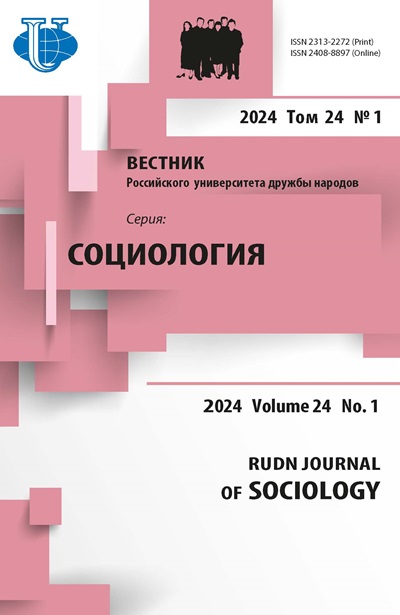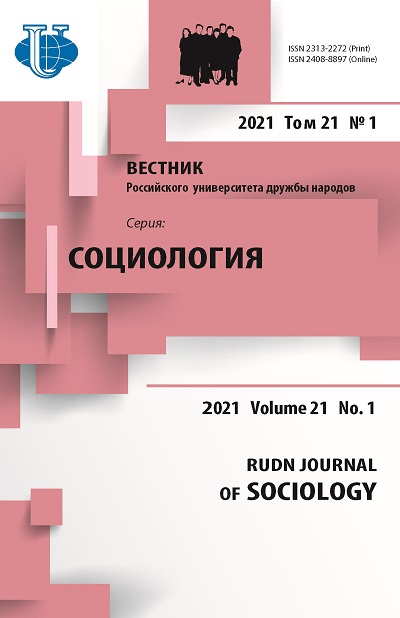Encyclopedias as tools of modernization: Stalinist versions of agrarian knowledge
- Authors: Nikulin A.M.1
-
Affiliations:
- Russian Presidential Academy of National Economy and Public Administration
- Issue: Vol 21, No 1 (2021)
- Pages: 154-168
- Section: Sociological Essays
- URL: https://journals.rudn.ru/sociology/article/view/25778
- DOI: https://doi.org/10.22363/2313-2272-2021-21-1-154-168
Cite item
Full Text
Abstract
The article considers directions of the agrarian modernization as presented in the four editions of the Soviet agricultural encyclopedia from the mid-1920s to the mid-1950s. On the basis of some historical examples and theoretical concepts, the author explains the scientific, ideological and political significance of encyclopedias in the formation of social knowledge and ideology; shows how during the Stalinist period, the Soviet agricultural encyclopedias passed through several successive ‘great leaps’ in the representation of agrarian knowledge under the accelerated Soviet modernization; stresses the manipulative way of managing agrarian knowledge and human capital in agriculture - on behalf of the leader and ruling party. The article describes the transition from the first Soviet encyclopedia of the 1920s, which focused on the modernization of peasant Russia, to the encyclopedia of the early 1930s, which denied the importance of the peasantry and praised the projects of large-scale industrial-agricultural production; many authors of the first peasant encyclopedia were repressed. The encyclopedia of the late 1930s reflects the fight against the authors of the previous encyclopedia of the ‘great leap’ and the purges in the name of the ideology of the planning-management approach in the further modernization of Soviet agriculture. The encyclopedia of the late 1940s - early 1950s reflects the victory of the technocratic-bureaucratic worldview and personnel approach to the agrarian sphere, which prevailed in the agriculture of the USSR until the very end of the Soviet era. The author focuses on the influence of the subjective factor (political leaders, editors-in-chief and anonymous authors) on the ideology, topics and style of encyclopedic articles. In conclusion, the author notes that the strong ideological control and volatile political situation distorted knowledge in the Soviet agrarian encyclopedias, which negatively affected the quality of rural human capital and largely predetermined the stagnation of rural development in the late USSR.
About the authors
A. M. Nikulin
Russian Presidential Academy of National Economy and Public Administration
Author for correspondence.
Email: harmina@yandex.ru
кандидат экономических наук, директор Центра аграрных исследований
Vernadskogo Prosp., 82, Moscow, 119571, RussiaReferences
- Benediktov I. A. Socialisticheskoe selskoe hozyajstvo i zadachi dalnejshego razvitiya [Socialist Agriculture and Tasks of Further Development]. Moscow; 1951. (In Russ.).
- Viliyams V.R. Osnovy zemledeliya [Fundamentals of Agriculture]. Moscow; 1939. (In Russ.).
- Viliyams V.R. Selskohozyajstvennaya entsiklopediya: Slovnik (predvaritelny) [Agricultural Encyclopedia: Glossary (Preliminary)]. Mоscow; 1939. (In Russ.).
- Gurov P.Ya., Goncharov A.D. Leninskaya agrarnaya politika [Lenin’s Agrarian Policy]. Moscow; 1973. (In Russ.).
- Krestyanskaya selskohozyajstvennaya entsiklopediya [Peasant Agricultural Encyclopedia. Vol. 1–7]. Mоscow; 1925–1928. (In Russ.).
- Lewin M. Sovetsky vek [The Soviet Century]. Mоscow; 2008. (In Russ.).
- Malaya selskohozyajstvennaya entsiklopediya [Small Agricultural Encyclopedia. Vol. 1–3]. Leningrad; 1927–1928. (In Russ.).
- Nikulin A.M. Shkola Chayanova: utopiya i selskoe razvitie [Chayanov’s School: Utopia and Rural Development]. Mоscow; 2020. (In Russ.).
- Merl S. Kak udalos Stalinu vosprepyatstvovat “zelenoj revolyutsii” v Rossii? K voprosu o tormozhenii agrarno-tekhnicheskogo progressa (1927–1941) [How did Stalin manage to prevent the ‘green revolution’ in Russia? On the inhibition of the agrarian-technical progress (1927–1941)]. Krestyanovedenie: Teoriya. Istoriya. Sovremennost. Mоscow; 2015. (In Russ.).
- Milyutin V.P. Agrarnaya politika SSSR [Agrarian Policy of the USSR]. Moscow; 1929. (In Russ.).
- Selskohozyajstvennaya entsiklopediya [Agricultural Encyclopedia. 1st edition. Vol. 1–4]. Moscow; 1932–1936. (In Russ.).
- Selskohozyajstvennaya entsiklopediya [Agricultural Encyclopedia. 2nd edition. Vol. 1–4]. Moscow; 1937–1940. (In Russ.).
- Selskohozyajstvennaya entsiklopediya [Agricultural Encyclopedia. 3rd edition. Vol. 1–5]. Moscow; 1949–1956. (In Russ.).
- Radkau J. Priroda i vlast: vsemirnaya istoriya okruzhayushchej sredy [Nature and Power: A Global History of the Environment]. Moscow; 2014. (In Russ.).
- Serge V. Ot revolyutsii k totalitarizmu: Vospominaniya revolyutsionera [From Revolution to Totalitarianism: Memoirs of a Revolutionary]. Moscow; 2001. (In Russ.).
- Scott J.S. Blagimi namereniyami gosudarstva [Seeing Like a State: How Certain Schemes to Improve the Human Condition Have Failed]. Moscow; 2005. (In Russ.).
- Stalin I.V. Voprosy Leninizma [Issues of Leninism]. Moscow; 1945. (In Russ.).
- Sobolev A.V. Aleksandr Vasilievich Chayanov: smena vekh [Alexander Vasilievich Chayanov: A change of milestones]. Fundamentalnye i prikladnye issledovaniya kooperativnogo sektora ekonomiki. 2015; 6. (In Russ.).
- Trotsuk I.V. Biologicheskoe, socialnoe i moralnoe v obyasnenii logiki istorii, ili stoit li iskat krestyanina v sovremennom mire [Biological, social and moral in the logic of history, or whether or not there is peasantry in the contemporary world]. Russian Peasant Studies. 2018; 3 (2). (In Russ.).
- Chayanov A.V. Kadry novogo zemledeliya [Workers for new agriculture]. VARNITSO. 1930; 1. (In Russ.).
- Shanin T. Chetyre modeli razvitiya sovetskogo selskogo hozyajstva [Four models of the development of Soviet agriculture]. Veliky neznakomets: krestyane i fermery v sovremennom mire. Moscow; 1992. (In Russ.).
- Bruish К. Als Das Dorf noch Zukunf war. Agrarismus und Expertise zwischen Zarenreich und Sowjetunion. Koln, 2014.
- Weiner D.R. Models of Nature. Ecology, Conservation and Cultural Revolution in Soviet Russia. University of Pittsburg Press, 2000.
- Heinzen J.W. ‘Peasants from the plow’ to ‘professors from the plow’: The culture of the Soviet people’s commissariat of agriculture, 1921–1929. Journal of Peasant Studies. 1998; 25 (2).
- Lindner P. Molecular politics, wearables, and the aretaic shift in biopolitical governance. Theory, Culture & Society. 2020; 37 (3).
- Merl S. Why the Soviet Union under Khrushchev and Brezhnev failed with the complex mechanization of agriculture: International aspects (1953–1986). Russian Peasant Studies. 2020; 5 (4).














